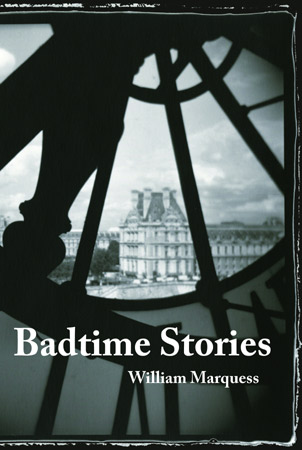
Fomite Press, 246 pages, paperback, $15.00
While billed as a collection of “ten linked stories,” William Marquess’s Badtime Stories could easily be called a novel. While the stories do jump around in time and feature the POV of various characters, they are so tightly interconnected, the book reads more like a novel in the style of As I Lay Dying.
Related Posts
The content, however, is closer to Stoner by John Williams. The book focuses on a family of a three — the wife, Ruth, an activist and college professor; the husband, “Mac,” a librarian; their only daughter, Harper (plus their dog, Sloppy Joe) — and like Stoner, it is a stoic, melancholic tale of people who married the wrong person and fail to live up to their own potentials.
To be honest, this was a difficult collection to get into because, in my opinion, the three weakest stories (or chapters, depending on your view of the book) are the first three of the book. Marquess starts out with “Night Train,” detailing an odd teenage romance of Harper’s, which, unfortunately, paints almost no picture of Harper’s character that is later revealed. Plus, the boy she dates is obnoxious, and the dialogue seems extremely contrived — “write what you know,” they say; here, Marquess seems out of his element.
The second story jumps back in time about fifteen years, detailing Harper’s parents’ trip to Paris, where they become engaged; however, it simply makes the characters seem unlikable. While this is fine — unlikable characters are crucial to storytelling — it does little to make the reader want to continue, as Ruth and Mac seem very one-dimensional. And who wants to read a whole book about unlikable characters who lack any complexity or depth?
The third story, “Badtime Story,” is a long-winded piece about Harper’s childhood sleep problems, and the tales that Mac would tell her to put her to sleep. This story serves several purposes: It shows the strong connection between Mac and his daughter; it shows the contrasting conflicts between both Ruth and her husband and Harper; and it develops the personalities of all three characters, allowing us to see facets we were previously denied. But if focuses too much on the stories Mac tells, and kind of loses me. I almost gave up after this one.
I’m so glad I didn’t.
The next eleven stories sucked me into the complex and often sad lives of all three characters. Using real-life settings and incidents in his hometown of Burlington, Vermont, Marquess creates a world and a family that seems so real, you think you know them. He gets into the mind and heart of Harper, a little girl growing up utterly detached from everyone around her. You ache to see her find her place in the world, despite her overbearing mother and the father she adores who ultimately fails her in the worst possible way.
Marquess (who battled and, sadly, recently succumbed to cancer himself) creates a sympathetic character in Ruth who, despite all her failings, cares deeply for her family and her job, while also having to undergo her own battle with cancer.
And then there is Mac.
Mac, who (personality-wise) is the more likable and relatable of the two parents, has such major failings that it is almost impossible to forgive him for his actions. But you feel for him as you see how the trajectory of his life, so different than what he imagined for himself, and so irredeemable in his own eyes, takes him down a dark, lonely path. You root for him, but by the time you get to the story “The Giant’s Wife” — a fascinating chapter, perfectly told from the POV of an elderly woman who runs a laundromat in Lunenburg, Vermont — you fully understand where he is headed. You begin to feel dread, but you read on anyway — because by this point, the book has become completely engrossing.
The ending of the book’s final story, “Carrying Capacity,” does not satisfy the way I wanted it to. It does not wrap things up as neatly I’d hoped, and I felt let down, not quite ready to let the characters go. But in life, you don’t always get exactly what you wish for, and what Marquess has created with Badtime Stories is — almost — as real as it gets. Despite the hesitation I felt after the first three stories, this is a wonderful read, well-worth seeking out.